120th Station Hospital Unit History

120th Station Hospital. Copy of the 1945 Christmas Menu, distributed by the command to its members while stationed in Bayreuth, Germany.
Introduction & Activation:
Pursuant to instructions contained in War Department Letter, File AG. 320.2 (7-14-42) MR-M-GN, dated 16 July 1942, Subject: Organization of Medical Corps Units in August 1942, and First Indorsement, Headquarters Eighth Service Command, same File and Subject as Letter, the following Medical Units are activated on dates shown at stations indicated below:
| Unit | Date | Station |
| 120th Station Hospital | 15 August 1942 | Camp Barkeley, Texas |
| 121st Station Hospital | 15 August 1942 | Camp Barkeley, Texas |
| 136th Station Hospital | 15 August 1942 | Camp Barkeley, Texas |
Activation of above Hospitals was confirmed by General Orders No. 14, Headquarters Camp Barkeley, Texas, ref. AHB/jeh/da, 12 August 1942, and signed by Major Armon H. Bost, Infantry, Adjutant. Copies of official documents were distributed to the Commanding General, Army Ground Forces; the Commanding General Services of Supply; and the Commanding Officers of the Eighth Service Command, 120th Station Hospital, 121st Station Hospital, 136th Station Hospital, 15th Hospital Center, and the Station Hospital, Camp Barkeley.
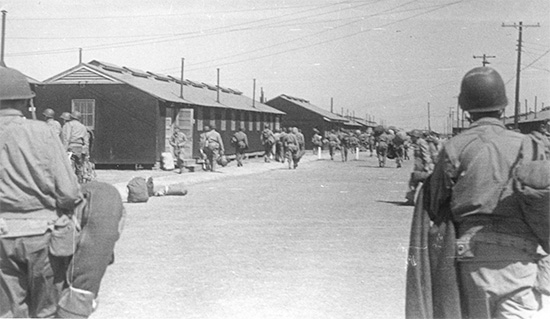
Photo of Camp Barkeley, Abilene, Texas. Staff and personnel of the 120th Station Hospital are returning from a road march to the Medical Replacement Training Center.
Organization:
Colonel Joseph Haas, MC, O-196248 (who saw service in WW1 with the 84th and 4th Divisions –ed) became the unit’s first Commanding Officer on 22 September 1942. He had supervised the early growth and training of the organization and was responsible for its establishment at Cp. Barkeley, Abilene, Texas (MRTC, acreage 69,879, troop capacity 3,192 Officers and 54,493 Enlisted Men –ed), where it started functioning as a Station Hospital for the first time. Under his guidance, the various professional departments were developed and organized.
The original cadre consisted of 1 Officer and 26 Enlisted Men. Early February 1944, it comprised 38 Officers, 78 Nurses, 2 Hospital Dietitians, 1 Physical Therapy Aide, and 390 Enlisted Men.

1942-1943 chart illustrating the organization of the Medical Corps Officer Candidate School, at Camp Barkeley, Abilene, Texas.
Movement Overseas:
In April 1943, the organization received alert orders to proceed to the New York Port of Embarkation. On 24 June 1943, the 120th Station Hospital personnel and staff departed New York POE with destination the United Kingdom. On board were 15,281 troops, and a crew of 927 men. Being a fast ship sailing with an average speed of 27.8 knots, she was able to cross the Atlantic in just a few days, reaching, Gourock, Scotland, 29 June 1943.
The RMS “Queen Mary” (ex-Cunard White Star Liner, launched 26 September 1934, provided trans-Atlantic passenger service between Southampton-Cherbourg-New York, with the outbreak of World War 2, she was converted into a troopship in Sydney, Australia, ferrying over 810,000 Allied soldiers for the duration of the war –ed).
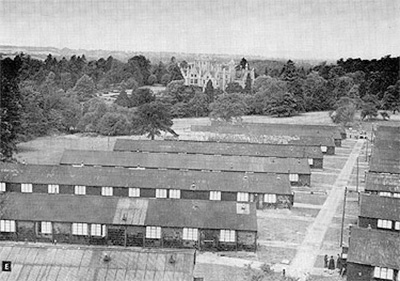
Partial view illustrating the installation of the 120th Station Hospital at Tortworth Court, near Falfield, England. Photo taken 5 August 1943.
| Officers Roster with Titular Functions (February 1944) | |
| Colonel Joseph Haas, MC, O-196248 | Commanding Officer |
| Lt. Colonel William G. Preas, MC, O-259326 | Executive Officer |
| Lt. Colonel Otto B. Hinz, DC, O-154962 | Dental Officer |
| Major Victor L. Cohen, MC, O-403180 | Asst. Chief of Medical Service |
| Major Lewis Grodsky, MC, O-237829 | Registrar |
| Major David L. Lerner, MC, O-1693359 | Chief of Medical Service |
| Major Elliott T. Thieme, MC, O-400278 | Chief of Surgical Service |
| Major Luther M. Vaughan, MC, O-346336 | Chief of Roentgenological Service |
| Captain Perry A. Anderson, MC, O-1821133 | Chief of Communicable Disease Section |
| Captain Frederick J. Andres, ChC, O-497441 | Chaplain |
| Captain Max Finkelstein, MC, O-1701069 | Chief of Cardiovascular Section |
| Captain Morris H. Geshwind, MC, O-1689519 | Chief Anesthetist |
| Captain Thomas W. Johnson, MC, O-460672 | Chief of EENT Section |
| Captain Andrew D. Johnston, MC, O-490216 | Chief of Laboratory Service |
| Captain Clyde B. Kayne, DC, O-470633 | Dental Officer |
| Captain Robert V. Lorimer, MC, O-486337 | Chief of Urology Section |
| Captain Jacob D. Matis, MC, O-1690615 | Chief of Gastrointestinal & General Section |
| Captain Lino A. Pagnillo, MC, O-492832 | Chief of Orthopedic Section |
| Captain Hermann K. Sachs, MC, O-504173 | Chief of Septic Surgery |
| Captain Irving A. Sarot, MC, O-1690439 | Ward Officer, General Surgery Officer |
| Captain Sidney A. Tyler, DC, O-484607 | Dental Officer |
| Captain Harry S. Weitzman, MC, O-284619 | Ward Officer, General Surgery Officer |
| 1st Lieutenant Roger D. Coleman, SnC, O-498756 | Sanitary Officer |
| 1st Lieutenant John E. Connor, MC, O-1691325 | Chief of Outpatient Dispensary |
| 1st Lieutenant Simon J. Conrad, MC, O-308799 | Neuro-Psychiatry Officer |
| 1st Lieutenant Seymour Egert, MAC, O- 1543453 | Commanding Officer Medical Department Detachment |
| 1st Lieutenant Smith L. Jenkins, MAC, O-1543257 | Personnel Officer |
| 1st Lieutenant Milton F. Leeds, MC, O-483236 | Chief of Anesthesia Section |
| 1st Lieutenant Philip C. McAllister, MC, O-886214 | Asst. Chief of Outpatient Dispensary |
| 1st Lieutenant Sylvia A. Michal, ANC, N-732925 | Chief of Nursing Service |
| 1st Lieutenant Ralph B. Richards, MAC, O-1542862 | Asst. Commanding Officer Medical Department Detachment |
| 1st Lieutenant Martin E. Rindsberg, MAC, O-1543258 | Mess Officer |
| 1st Lieutenant Edwin G. Schonwalter, MAC, O-542942 | Medical Supply Officer |
| 1st Lieutenant Lawrence L. Smith, MAC, O-1542991 | Adjutant |
| 1st Lieutenant Frederick T. Steen, ChC, O-491250 | Chaplain |
| 1st Lieutenant Zachary Yarchoan, DC, O-464448 | Dental Officer |
| 2d Lieutenant Albert M. Hansen, MAC, O-1543481 | Asst. Registrar |
| 2d Lieutenant William J. Oswald, MAC, O-1543507 | Asst. Mess Officer |
| 2d Lieutenant Owen E. Simonson, MAC, O-1542995 | Transportation & Utilities Officer |
United Kingdom:
The 120th Station Hospital arrived in England, on 1 July 1943. Part of the unit was quartered together with the 160th Station Hospital at Lilford, Hunts., England, while the remainder of the unit and Headquarters were established at the 2d Evacuation Hospital at Diddington, Hunts., England (APO # 508).

Partial Layout Plan (Drg No. 1/A/5 dated 25 Nov 1942) drawn by Messrs. Abell House, Westminster, England upon instructions from the British Ministry of Works illustrating E. H. Tortworth Court accomodation and installation, to be used by the US Army 120th Station Hospital.
The 120th Station Hospital functioned as a medical unit for the care of sick American and British personnel since its official opening on 1 September 1943, and also supplied sick call, clinic, and laboratory services for any of the surrounding military establishments.
The original supplies were slow in arriving but were gradually obtained. On two occasions the unit received large numbers of patients in one group: once, when some 200 non-ambulatory patients were received by ambulance, and on 15 December 1943, when a group of 293 patients were received by Hospital Train. Admission and reception of these patients proceeded smoothly and efficiently on both occasions. The professional care rendered to patients at all times was consistently good; and met with the approval of the professional medical consultants.
Weekly scientific meetings were held to which numerous Officers pertaining to the nearby medical units assisted. A comprehensive training program for the improvement of training methods used for the Enlisted Men and Nurses was consistently followed. A large ward was set aside for any emergency reception of shock patients, as well as an auxiliary OR where surgery could be performed in the event of an enemy blitz.
There were no VD cases within the organization for the year 1943.

Group of male and female Student Officers attending the second course of Anesthesia organized by the 120th Station Hospital at its premises, Tortworth Court, 21-26 February 1944.
During the first week of January 1944, the 705th Medical Sanitary Company moved into the Hospital area to help with the construction of the covered runways and pathways connecting the Medical and Surgical Wards. The work was begun shortly thereafter and was carried out with the help of unit labor and the technical assistance of a Sergeant detailed from the 355th Engineer General Service Regiment (activated 1 September 1942, embarked for England 21 October 1943, arrived in England 3 November 1943 –ed). The project was completed in about two months and turned out to be a skilfully constructed job.
The first of a series of Anesthesia Schools was started on 17 January under the direction of Lt. Colonel Tovell. The number of students attending this class was 30 Medical Officers and 15 ANC Officers from various medical units. The student Officers and Nurses were housed and fed by the organization with hospital facilities and some of its staff were used in the course of instruction. Due to its success, a second Anesthesia School was held on 21 February 1944. The latter was attended by 37 Medical Officers and 22 Nurses.
A program of fostering British-American relationship was continued actively during the month of February when a number of visiting civilians representing the British Red Cross and Saint John’s Ambulance were officially invited to the institution. A number of official inspections also took place during the same month, including visits by Major General Paul R. Hawley (Chief Surgeon, USAFBI, May 1942, later Chief Surgeon, ETOUSA & SOS, September 1942 –ed) and Brigadier General Leon A. Fox.
On 15 March 1944, the 120th was inspected once more by Major General P. R. Hawley and Major General Norman T. Kirk (US Surgeon General –ed).
The month of March was further marked by the sending of several Dispensary Teams to the XIX District Headquarters for service with troop movements in southwest England.

Typical illustration of British Anesthesia apparatus used in British Hospitals in October 1942 and supplied to United States Army Military Hospitals arriving in the British Isles for the Allied build-up.
A group of Officers and Enlisted Men were sent to establish Headquarters at Pinkney Park, Wilts., England. Colonel Joseph Haas, several Medical Officers, 15 Enlisted Men, and all the Nurses proceeded to Swindon, Wilts., England, where the Nurses’ Provisional Battalion was to be organized, with Colonel J. Haas, commanding, in addition to his commanding the 120th Station Hospital.
During the month of April, the unit went through an intensive training program at Pinkney Park, with emphasis placed on conditioning in preparation for field duty. The basic medical and technical subjects were repeated and a great amount of time devoted to the physical conditioning of Officers and Enlisted personnel. The ANC complement, attached to the Nurses’ Provisional Battalion, stationed at Swindon, later moved to the 25th General Hospital at Cirencester, Glos., England. They too took part in an intensive training program in both places.
The 120th Station Hospital, consisting of 35 Officers, 1 Warrant Officer, and 349 Enlisted Men, moved from Pinkney Park, Wilts., England to Charlton Park, Malmesbury, Wilts., England, APO # 63, for a permanent change of station. Suitable quarters were available at the new location. Camp or barrack equipment was not to be taken from the accommodations being vacated, only individual and organizational equipment was to be taken along. Movement by motor convoy was authorized. Instructions were received by Letter dated 8 May 1944 by command of Brigadier General Charles O. Thrasher, Headquarters, Southern Base Section, SOS, ETOUSA, United Kingdom, APO # 519.

Copy of Letter (Hospital Orders No. 21, dated 19 June 1944, issued by Headquarters, 120th Station Hospital, APO 165, US Army, signed by Captain Jacob D. Matis, MC, Executive Officer) announcing the official opening of the 120th Station Hospital, at 0001 hours, 20 June 1944 at Charlton Park, near Malmesbury, England.
On 28 May 1944, the Detachment, 120th Station Hospital, consisting of 3 Officers and 71 ANC Officers were instructed to depart from Cirencester Park # 2, Glos., England, for Charlton Park, Wilts., England, and report to the CO, 120th Station Hospital for permanent station, where they would help operate Hospital Plant # 4135. The transfer was to be made by Government motor transportation. Movement Orders were received by Letter dated 28 May 1944 by command of Brigadier General Charles O. Thrasher, Headquarters, Southern Base Section, SOS, ETOUSA, UK.
Memorial Day, 30 May 1944, was celebrated by religious services on the Post and in the same afternoon a delegation of Officers and Enlisted Men visited Garsdon Church, where a wreath was laid at a Tablet dedicated to the Washington Family who once worshipped there.
During the reconstruction and renovation phase, many Medical Officers and some 100 odd EM were working on DS in southwest England, returning during the month of June. Hospital supplies were of the American type and arrived in good condition. In addition to a total of 12 ward blocks, which could accommodate 750 patients, tent sites for 27 expansion ward tents were laid to increase the total bed capacity of the institution to 1,115.

Photo illustrating a group of ANC Officers of the 120th Station Hospital while training in Swindon and Cirencester, England, April-May 1944. Nurses wash and rinse their mess kits in the immersion heaters after chow.
One of the problems affecting the organization was the lack of enough transportation. Fortunately, a neighboring Quartermaster Truck Battalion was of much help providing a certain number of badly-needed vehicles. While reorganizing and equipping the installation, the 1301st Engineer General Service Regiment (activated 25 June 1943, embarked for England 24 March 1944, arrived England 5 April 1944 –ed) furnished help with construction equipment and supervision for much of the hospital site.
At the end of June, the 120th was fully equipped and staffed for the reception of patients, especially a mass influx of casualties resulting from the D-Day operations on the Continent.
The following Officers were assigned to and joined the 120th Station Hospital, while in the United Kingdom: Captain Alfred R. Brin (O-367412), Captain John E. Eggleston (O-401696), Captain Earl L. Grose (O-523508), Captain Lewis S. Kramer (O-519268), 1st Lieutenant Mario G. Cirelli (O-534891), 1st Lieutenant Norman F. Finkelstein (O-506411), 1st Lieutenant Paul N. Siegel (O-1543308), and Warrant Officer (Junior Grade) Leo J. Conley (W-2132749). A number of other Officers and Nurses received promotions. They included: Lieutenant Colonel Elliott T. Thieme (O-400278), Major Clyde B. Kayne (O-470633), Captain John E. Connor (O-1691325)and Captain Milton F. Leeds (O-483246).
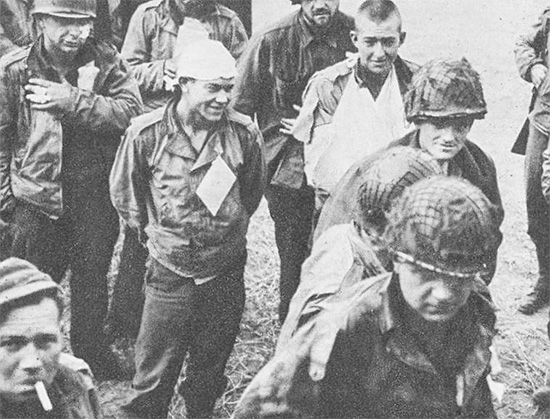
June-July 1944. Arrival of American casualties in the United Kingdom following the D-Day landings and operations on the continent.
During its PW period the organization was usually operating at full bed capacity. Most of the enemy patients were rather severely wounded and almost all work was surgical. The German Sanitäter who had been assigned as permanent cadre were voluntary and willing workers and there was no disciplinary problem at any time. Some 20 German Nurses also helped, while it should be underlined that the German Medical Officers acted more or less as observers rather than actual help. Any problems involving processing, feeding, and security of the enemy patients were met as they arose and were satisfactorily solved.
Early in October, 4 Officers and approximately 20 Enlisted Men were given the opportunity to return to the Zone of Interior, accompanying patients for further treatment. This was a source of great stimulation for the entire unit. During the period another training program was in force for Officers, Nurses, and Enlisted personnel.
In November 1944, the 120th became part of the newly-organized III Hospital Group (Provisional) which later was to become the 803d Hospital Center with Headquarters at Devizes. Starting in December all ward tents were winterized by the addition of wooden sides and a door; the Officers’, Nurses’ and Enlisted Men’s tentage was likewise winterized. Throughout the New Year, an effort was made to improve the physical plant and keep it in a good state of repair; repairs always remained a problem since the installation was a conversion type of camp and facilities were not of a permanent nature.
During the months of January and February 1945, the Hospital continued to operate at its maxim bed capacity of 1,311. One of the reasons for the high census of patients was their slow evacuation to the Zone of Interior and convalescent facilities. Fortunately during the month of March the situation improved greatly with some of the wounded being evacuated within several days after being reported for immediate air evacuation. Cases dropped sharply towards the end of March to an average census of approximately 750 patients. During the period from January until February, trench foot continued to be the cause of almost one quarter of all admissions. Most of these patients were placed in the Rehabilitation Program and within a period of about thirty days returned to duty. Arriving in the middle of January and staying for almost one moth, 100 Enlisted Men of the 80th Field Hospital were sent on DS with the 120th. This was a great help in carrying the patient load which was about double the size of the organization’s normal T/O capacity. Five (5) Nurses from a nearby Evacuation Hospital were furthermore assigned on detached service for a similar period. By the end of January 1945, a Hospital Sub-Depot in Swindon, opened its doors to draw food rations, which was a marked improvement over the former system of having to travel to Depot G-35 in Bristol, to draw food and rations. ARC personnel started arriving at the beginning of February 1945 and immediately began to fill a much neglected need for the patients’ facilities. They set up a separate Red Cross building and utilized part of an existing building for an Arts & Crafts shop. Repeated efforts were made to obtain sufficient radios so that there could be more music and broadcasts around the wards. A Public Address system was requisitioned but was unfortunately not forthcoming.
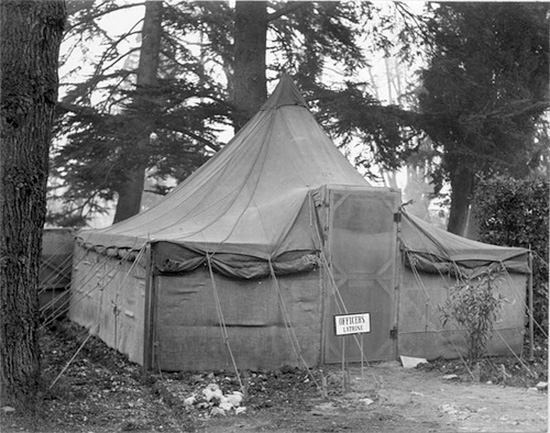
Photo illustrating winterization of tentage. This particular photo shows a winterized M-1934 Pyramidal Tent used as an Officers’ Latrine.
On 15 April 1945, Memorial Services were held for President Franklin Delano Roosevelt (1882-1945 –ed) whose unexpected death from a stroke was a great shock and loss to the entire Post community.
In April, the unit forwarded 2 Officers (1 MC and 1 MAC) and 4 Enlisted Men on DS to the Continent to work in connection with RAMPS, Recovered Allied Military Personnel.
On 28 April 1945, at 1700 hours, word was received that all patients were to be immediately evacuated to neighboring hospitals. The majority was transferred the next day and after two days the Hospital was empty of patients. At midnight, 1 May 1945, the 120th Station Hospital closed. Medical supplies were collected, repacked and returned to the different depots with speed and exactness under the able supervision of Captain Edwin G. Schonwalter, Medical Supply Officer, O-1542942.

Photo of German Prisoner of War Labor Detail at work. While in the United Kingdom (later also applied on the continent), German PWs (non-medical personnel) were often used to supplement personnel taking over some of the more menial tasks. They were also employed in repair, maintenance, construction, and landscaping, and generally performed well, being housed, clothed, fed, and medically supported by the Hospital.
France:
After receiving the necessary alert orders, the 120th Station Hospital was instructed to move to Le Havre, France. V-E Day found the unit busily engaged in preparation for its short voyage across the Channel with destination the Continent. On this day preliminary orders were received and there was much joyous celebration within the Post to celebrate the move. On 20 May 1945 the unit bid farewell to the United Kingdom embarking on the Liberty Ship “Marine Wolf” at Southampton, England with destination the Port of Le Havre, France. Upon arrival, the organization staged at Camp “Twenty Grand” one of the many Cigarette Camps established in France. The 120th Station remained non-operational from 20 May until 15 August 1945 awaiting further movement orders. Over the same period, the Nurses were removed from the unit and staged at Neufchâtel, in the Pas-de-Calais region, North Eastern France. The Hospital was eventually re-assembled at the Maginot-Niel Medical Staging Area in Verdun, France, awaiting further redeployment in the European Theater. During staging, 17 ANC Officers volunteered for duty in an active Theater, while 30 qualified Enlisted Men were selected to supplement units on alert and scheduled for the CBI Theater. For the remaining Officers and Nurses, a multitude of temporary duties was offered from the Chanor Base Section up to different outposts on the Continent. This depleted the unit’s staff to such a degree that by 30 June 1945, 25% of the Nursing staff and 50% of the Enlisted Men only remained on duty looking forward to another assignment (most probably as part of the Occupation Forces in Germany –ed).
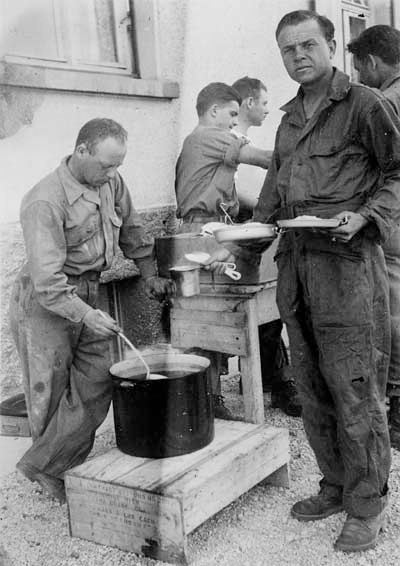
1945, somewhere in Germany. Photo illustrating a chow line of Enlisted Men of the 120th Station Hospital.
Germany:
The 120th Station now under Alert Orders issued by the Oise Base Section, began recalling its personnel on DS and TD, to prepare for another permanent change of station.
The organization finally got on the move again entraining for Bayreuth, Bavaria, Germany where it established in the “Winifred Wagner Heim” Hospital, APO # 655, on 4 August 1945. The site had been first occupied by the 128th Evacuation Hospital in June 1945. Although constructed between 1938 and 1942 under the NSDAP Welfare Group “Kraft durch Freude”, it served in different roles; as a maternity and later as a Luftwaffe Lazarett. It was one of the modern plants incorporating advanced construction design with large and well-ventilated rooms, excellent surgical and obstetrical facilities, running hot and cold water, a central heating plant, and exceptional kitchen, laundry and storage facilities. Several alterations and new constructions were necessary to convert the hospital to military requirements, and increasing the 500-bed installation to a 750-bed hospital plant.
Within a few weeks the patient census rose well over 600. The majority of admissions constituted vehicle accidents and personnel suffering from VD. As it became apparent that additional space would be required to house the hospital staff and its patients, Third United States Army sent a Hospital Construction Team to survey and make plans for additional Officers and Enlisted personnel barracks, chapel, theater, and motor pool. Plans were subsequently approved and work orders given to a group of IV Corps Engineers.

Spring of 1945, Germany. Extra Ward or Squad Tents were often pitched to absorb a particularly high patient census. Such measures were implemented when large numbers of patients were expected, such as battle casualties, recovered Allied military personnel, political prisoners, displaced persons, and enemy prisoners of war …
A change in command took place with the relief of Colonel Joseph Haas, MC, O-196248, by Colonel Rex C. House, MC from the 6th Convalescent Hospital who took over command 14 September 1945. The only solution to try and solve the lack of sufficient personnel was hiring German civilians and Displaced Persons and employ them in some of the sub-professional, technical, and routine duties required in the daily operation of a hospital. Only a few capable and qualified Technicians were found to fill some of the vacancies in the Laboratory, Dental Clinic, X-Ray and Wards. Vacancies continued to occur rapidly due to the Redeployment policy, but replacements were not considered satisfactory. When the 67th Evacuation Hospital was officially closed for operation at 2400 hours, 17 November 1945, the remaining 403 patients were evacuated to the 120th at Bayreuth (17 Nov 45 –ed)and the 125th Station Hospital at Passau (18 Nov 45 –ed), Germany (the 67th Evac had been alerted for redeployment to the Zone of Interior –ed). On 21 November 1945, another transformation took place in the Enlisted personnel. Low Point EM of the 123d Evacuation Hospital replaced the remaining Enlisted Men of the unit and began immediate operation. During the same month, patient census dropped markedly and by the end of December 1945, the number was down to 291 patients. The last two months of 1945 brought about a complete transformation of the 120th Station Hospital with only 5 original Medical Officers – 1 original ANC Officer – and no original Enlisted Men remaining!

Sketch illustrating the 120th Station Hospital located on the outskirts of Bayreuth, Germany, where the unit provided medical support to the US Occupation Forces.
Postwar:
The new Commanding Officer to be was Lt. Colonel Charles H. Schutt, MC.
When the numbers of hepatitis cases continued to increase in the occupation years, a Hepatitis Center was established at the 120th Station Hospital, Bayreuth, Bavaria, Germany. From this institution came early descriptive studies of the epidemiology of the disease. With time, additional expansion projects grew including the necessary space for more sports and recreation, including the building of a picnic area, volley ball, horseshoe, and badminton courts, a baseball diamond, a golf driving range, riding stables, and an outdoor grill. Under construction were tennis courts, a static water supply, a garage, and an indoor theater. It is believed that the organization would become one of the best equipped US Army Hospitals in Germany.
Copies of vintage Unit History documents were generously donated by the late Lynn F. McNulty, son of Captain Frederick J. McNulty (ASN:O-526873). His continuous support and assistance to the MRC Staff were always very much appreciated. We are still looking for a complete Personnel Roster. All inputs appreciated. Thank you.
